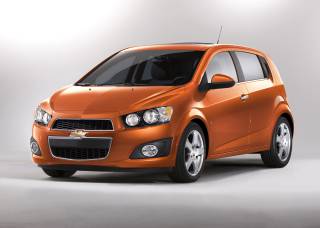
The all-new Chevrolet Sonic’s style, ride quality and fun-to-drive nature land the new car well past the Chevrolet Aveo it replaces and establish it as a competitive player in the exploding subcompact field.
Chevrolet accomplished its goal of creating a sport-oriented Sonic, but buyers on a budget will have to decide if fun is more important than fuel economy. The base 1.8-liter engine’s 35 mpg highway rating is merely average in a segment where high gas mileage and low prices flourish. The Sonic’s optional turbocharged 1.4-liter engine boosts mileage to 40 mpg on the highway, though for now it’s only available with a six-speed manual transmission. A six-speed automatic, now optional with the base engine, will be available with the turbo engine in spring 2012.
The Sonic is available as a sedan or hatchback in LS, LT and LTZ trims. I test-drove the sedan and hatchback versions of the LT and LTZ.
What’s Cookin’, Good Lookin’?
The Sonic’s sharp lines and aggressive styling stand out among the many uninteresting-looking cheap cars on the market (hello, Nissan Versa). The most attractive color combination I spotted was a black sedan with an optional dark-red “brick” dashboard, available on LT and LTZ models. That color combo conjures images of a 1957 Chevrolet Corvette or the Adam West-era Batmobile, both of which undoubtedly wore it better than the Sonic does. Still, it’s a stylish contrast on the Sonic.
The hatchback’s outline resembles the old Aveo. The redeeming quality there is that at first glance the hidden rear door handle — it’s behind the window instead of on the door — makes the hatchback look like a coupe. It took me a few embarrassing attempts grasping at sheet metal to find the real handle, but owners will quickly adjust to the non-traditional location.
The Sonic is fitted with standard alloy wheels of 15, 16 or 17 inches, a rarity in a segment where steel wheels and plastic covers are the norm. Chevrolet says the increased rigidity of an alloy wheel gives the desired low levels of noise, vibration and harshness. The expense seems worth the cost, as the Sonic is quiet on the inside, with few rattles and unwanted noises.
Performance
The Sonic showed off its sporty aptitude on the twisty California roads where I drove it, exhibiting good composure and minimal body roll. Back on city streets and highways, the Sonic’s solid, composed ride is impressive for a small car. There’s a feeling of sturdiness and heft over bumps and uneven pavement.
The Sonic’s engines are taken directly from the Chevy Cruze. A 1.8-liter four-cylinder is standard on all trim levels, while a turbocharged 1.4-liter can be had on LT and LTZ trims. The lighter Sonic is peppier and more responsive than its larger sibling. Differentiating the 1.4-liter from the base engine, besides the additional $700 it will cost you, is an additional 23 pounds-feet of torque.
Though the two engines’ horsepower ratings are the same, the turbo engine’s advantage is most evident on winding roads, where its greater torque at lower rpm hastily pulls the car out of corners. The base engine takes more time to wind out at low speeds, while the 1.4 is ready to go at the press of the accelerator.
Transmission choices include a standard five-speed manual and an optional six-speed automatic for the base engine. Just the six-speed manual comes with the turbo engine. The fun-to-drive factor is highest with the manual and turbo 1.4-liter, though the six-speed automatic paired with the base engine is surprisingly proficient at holding lower gears, keeping the revs up during spirited driving.
Back where I normally drive — the grid street layout of suburban Chicago — the 1.4-liter’s strengths would scarcely be used. The Sonic’s straight-line acceleration doesn’t feel enough stronger than the base engine to warrant the extra cost, and even the increased gas mileage might not be worth your money: It could take a few years of saving at the pump to recoup the initial expense.
Gas Mileage
The base engine’s gas mileage is simply unimpressive against the competition. The Sonic’s 1.8-liter engine is expected to be the big seller, and it’s rated 26/35 mpg city/highway with the five-speed manual transmission and 25/35 mpg with the available six-speed automatic. Optional turbocharged models rate a more respectable 29/40 mpg.
When paired with an automatic transmission, a Ford Fiesta (without the Super Fuel Economy Package) is rated 29/39 mpg. The Versa is 30/38 mpg, and the Hyundai Accent is 30/40 mpg. Fueleconomy.gov estimates those three will save $278 annually over a base Sonic; Fueleconomy.gov assumes 15,000 miles of driving and uses national fuel-price averages in its calculations.
Interior & Cargo
Compared with the Aveo, passenger room is relatively unchanged, so the Sonic feels like a small car on the inside. Sitting in the driver’s seat, my left foot easily reached the floorboard, elevating my knee during normal driving. Moving the seat back any farther would have put the steering wheel out of reach, even with its telescoping adjustment fully extended. Front seat comfort, at least, is exceptional with both the LT’s cloth and the LTZ’s leatherette (faux leather) seats.
Affordable cars rarely have features that deserve “Dude, check this out” reactions, but inside the Sonic is a motorcycle-inspired gauge cluster that elicits that response. The display shows off vehicle speed, engine speed and other vital stats. It’s standard equipment. A brightly lit digital speedometer and analog tachometer are fused close together for easy reading in daylight or at night.
Accounting for the techies among today’s drivers, the dashboard sports two large storage cubbies on each side of the radio that make for valuable space. I stored my phone, wallet, keys and notepad, with room to spare.
Those planning to cart around friends should consider the hatchback for the additional rear headroom it offers. I’m 6 feet tall, and my scalp rubbed the sedan’s ceiling. The hatchback provided about an inch of scalp relief. Backseat legroom is in short supply with the driver’s seat positioned where I needed it. At least the seatback’s cushioning is supple enough that I didn’t mind resting my knees against the seat.
The interior is a complete redo from the Aveo. Unlike the Fiesta’s Euro-feel button layout, the Sonic’s dashboard controls are a more typical design, which I prefer for ease of use. The Sonic’s choice of interior materials, plus its fit and finish, put it on par with subcompacts like the Hyundai Accent and Fiesta. I’d give an edge to the Fiesta, however, for its flowing, uniform styling, plus its higher-quality dashboard materials.
Unlike passenger dimensions, cargo room has grown in both the sedan and the hatchback. For a small car, the sedan’s trunk is large — 14 cubic feet, up from the Aveo’s 12.4 cubic feet — plus it features a standard 60/40-split folding backseat. The hatchback also stacks up larger than average, with 19 cubic feet of cargo space behind the rear seat, up from 15.0 cubic feet in the Aveo. The 30.7 cubic feet you’ll get with the seat folded isn’t as large as the Accent or Versa hatchbacks, but it is more than the Fiesta offers.
Features & Pricing
Chevrolet uses a similar pricing approach with the Sonic as it does the Cruze. The base model comes well-equipped at a higher price than some competitors, as opposed to a rock-bottom price that impresses at a glance but comes with few features.
The $13,735 starting price (not including a $760 destination fee) includes features uncommon in the segment, including a tilt/telescoping steering wheel, a height-adjustable driver’s seat, a driver’s armrest, alloy wheels and hill-hold assist for manual versions. Air conditioning, power door locks and remote keyless entry are also standard.
The most-expensive LTZ trim level ($16,535 for the sedan) gains leatherette upholstery, heated front seats, a USB input for music players, Bluetooth, cruise control and steering-wheel audio controls. The faux leather would look much better without its perforations on the seat and back cushions; they make it look cheap compared with the optional leather interior on the Fiesta. The cloth seats are just as comfortable as the leatherette seats, but cloth can’t be had on heated seats.
The available iPod integration includes Bluetooth streaming audio and functions very much like the stereo in the Cruze and other GM products. The Fiesta’s optional Sync system has an edge in its voice commands, which make it easier to select songs from a large music collection.
Safety
The 2012 Sonic earns the Insurance Institute for Highway Safety’s highest accolade of Top Safety Pick, having earned the agency’s best score, Good, in frontal, side, rear and roof-strength tests. As of this writing, the Sonic had not been crash-tested by the National Highway Traffic Safety Administration.
Ten airbags are standard, including front, side-impact and knee airbags for front occupants, plus side curtain airbags for front and rear passengers. Antilock brakes, stability and traction control are also standard.
Sonic in the Market
Logical buyers looking strictly at the numbers may not find the base Sonic’s high starting price and lackluster gas mileage attractive. The Sonic’s aggressive styling and sporty driving experience appeal to shoppers who are more in tune with their emotional side, a rare strategy among cheap cars.
Based on driving experience and style, the Sonic works. Even its higher price is justifiable thanks to the numerous standard features. If Chevrolet managed to squeak out better gas mileage from base models, buyers’ pesky logical voices would be easier to quiet.
Snapshot:
Starting MSRP $13,735–$18,495
MPG
City: 25 – 26
Highway: 35
Available Engines
138-hp, 1.8-liter I-4 (regular gas)
138-hp, 1.4-liter I-4 (regular gas)
Transmissions
6-speed manual w/OD
6-speed automatic w/OD
5-speed manual w/OD
New or Notable
• New for 2012
• Replaces Aveo
• Fresh four-cylinder engines from Cruze
• 1.8-liter or turbo 1.4-liter
• Sedan or hatchback
• Six-speed automatic transmission
What We Like
• Higher-quality interior than Aveo
• Standard alloy wheels
• Aggressive looks
• Engines
What We Don’t
• Less rear headroom in sedan than in hatchback
• Most models rated below 40 mpg
• Pricey for a subcompact


























